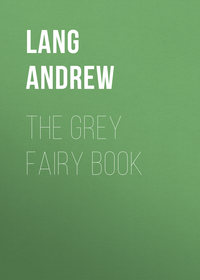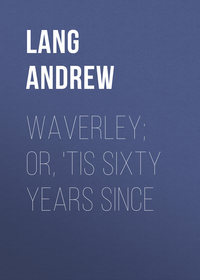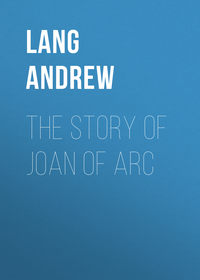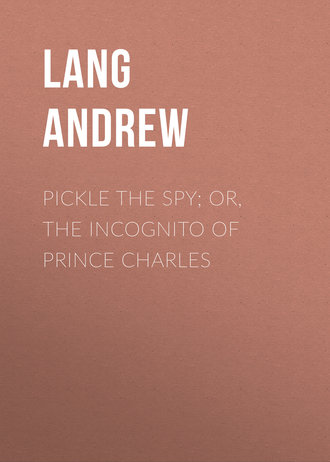 полная версия
полная версияPickle the Spy; Or, the Incognito of Prince Charles
93
Montesquieu to the Abbé de Guasco, March 7, 1749.
94
The sequel of the chivalrous attempt to catch Keith’s mistress may he found in letters of Newcastle to Colonel Guy Dickens (February 12, 1751), and of Dickens (St. Petersburg, March 27, 30, May 4, 1751) to the Duke of Newcastle. (State Papers.)
95
Correspondence of the Duke of Bedford, ii. 69.
96
Letters, ii. 116.
97
Spence’s Anecdotes, p. 168.
98
Browne, iv. 17.
99
Stuart Papers.
100
Ibid.
101
Potzdam, August 24, 1751. Œuvres, xxxviii. 307. Edition of 1880.
102
Newcastle to Lord Chancellor, September 6, 1751. Life of Lord Hardwicke, ii. 404.
103
Anecdotes.
104
Stuart Papers. Lady Montagu was Barbara, third daughter of Sir John Webbe of Hathorp, county Gloucester. In July 1720 she married Anthony Brown, sixth Viscount Montagu.
105
Walton’s Life of Wotton.
106
Browne, iv. 89–90.
107
S. P. France, 455.
108
S. P. Poland, No. 79.
109
Angleterre, 81, f. 94, 1774.
110
Pichot, in his Vie de Charles Edouard, obviously cites this document, which is quoted from him by the Sobieski Stuarts in Tales of the Century. But Pichot does not name the source of his statements.
111
A French agent, Beson probably, whom Charles desired to dismiss, because a Frenchman.
112
Scott’s Letters, ii. 208. June 29, 1824.
113
For reasons already given, namely, that Madame de Vassé was the only daughter of her father by his wife, and that Mademoiselle Ferrand was her great friend, while the Prince addresses Mademoiselle Luci by a name derived from an estate of the Ferrands, I have identified Mademoiselle Ferrand with Mademoiselle Luci. This, however, is only an hypothesis.
114
Some of Pickle’s letters were published by Mr. Murray Rose in an essay called ‘An Infamous Spy, James Mohr Macgregor,’ in the Scotsman, March 15, 1895. This article was brought to my notice on June 22, 1896. As the author identifies Pickle with James Mohr Macgregor, though Pickle began to communicate with the English Government while James was a prisoner in Edinburgh Castle, and continued to do so for years after James’s death, it is plain that he is in error, and that the transactions need a fresh examination. Mr. Murray Rose, in the article cited, does not indicate the provenance of the documents which he publishes. When used in this work they are copied from the originals in the British Museum, among the papers of the Pelham Administration. The transcripts have been for several years in my hands, but I desire to acknowledge Mr. Murray Rose’s priority in printing some of the documents, which, in my opinion, he wholly misunderstood, at least on March 15, 1895. How many he printed, if any, besides those in the Scotsman, and in what periodicals, I am not informed.
115
The portrait, now at Balgownie, was long in the possession of the Threiplands of Fingask. I have only seen a photograph, in the Scottish Museum of Antiquities.
116
MS. in Laing Collection, Edinburgh University Library.
117
A note of Craigie’s communicated by Mr. Omond.
118
Cope to Forbes of Culloden, August 24, 1745. Culloden Papers, p. 384.
119
Culloden Papers, p. 405.
120
Young Glengarry to Edgar. Rome, September 16, 1750. In the Stuart Papers.
121
Chambers’s The Rebellion, v. 24. Edinburgh, 1829.
122
Letter of Warren to James, October 10, 1746. Browne, iii. 463.
123
Stuart Papers. Browne, iv. 100.
124
Ibid. iv. 22, 23.
125
Browne, iv. 51.
126
Browne, iv. 61, 62.
127
I presume the first beautiful Mrs. Murray is in question. The second is ‘another story.’ See the original letter in Browne, iv. 90–101.
128
State Papers, Domestic, No. 87.
129
Stuart Papers.
130
Browne, iv. 60.
131
Browne, iv. 117.
132
Correspondence of the Duke of Bedford, ii. 39.
133
Paris, February 14, 1752. Stuart Papers.
134
iv. 84.
135
Rome, September 4, 1750. In Browne.
136
Browne, iv. 102.
137
Journal, February 14, 1826.
138
May 4, 1753. Stuart Papers. To old Edgar.
139
His father’s name was John. One of Pickle’s aliases.
140
This identifies ‘Pickle’ with ‘Jeanson.’
141
Cypher names.
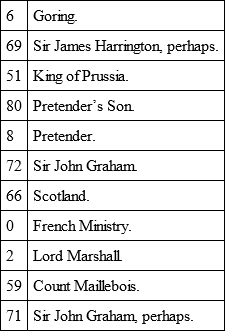
142
That is, probably, Pickle said to Jacobite friends that his money came from Major Kennedy.
143
Lord Elcho knew it, probably from his brother.
144
Elcho says he was in London, at Lady Primrose’s. We have seen that Charles had had a difficulty with this lady.
145
To this illness Glengarry often refers, when writing as Pickle.
146
Hay to Edgar, October 1752. In Browne, iv. 106.
147
‘Mildmay’ to ‘Green,’ January 24, 1753.
148
S. P. Poland. No. 81.
149
Carlyle’s Frederick, iv. 467. Compare, for the views of political circles, Horace Walpole’s Reign of George II. i. 333, 353, and his Letters to Horace Mann for 1753.
150
Reign of George II. i. 290.
151
Add MSS. British Museum, 33,847, f. 271. ‘Private and most secret.’
152
Politische Correspondenz Friederichs des Grossen. Duncker. Berlin, 1879, ix. 356.
153
Can the Earl and the Doctor have approved of renewing the infamous Elibank plot?
154
Many historians, such as Lord Campbell in his Lives of the Chancellors, condemn as cruel the execution of Cameron. But the Government was well informed.
155
The Active Testimony of the Presbyterians of Scotland, 1749.
156
xix. 742.
157
French service. He seems to think that Archy was betrayed by French means. He perhaps suspected Dumont, who had been in the French army.
158
Glengarry had been a captain in the French service.
159
Brother of d’Argenson of the Mémoires.
160
Pol. Corr. No. 5,933.
161
As early as 1748 Dawkins was in Paris, drinking with Townley, who calls him un bon garçon. Townley’s letters to a friend in Rome were regularly sent to Pelham.
162
Pol. Corr. ix. 417. No. 5,923.
163
Droysen, iv. 357. Note 1.
164
S. P. France. 462.
165
Browne, iv. p. 111.
166
In his article on James Mohr (Scotsman, March 15, 1896), Mr. Murray Rose cites some papers concerning James’s early treacheries. For unfathomable reasons, Mr. Murray Rose does not mention the source of these papers. This is of the less importance, as Mr. George Omond, in Macmillan’s Magazine, May 1890, had exposed James’s early foibles, from documents in the Record Office.
167
Trials of Rob Roy’s Sons (Edinburgh, 1818), p. 3.
168
The reader may remember that Pickle’s earliest dated letter is from Boulogne, November 2, 1752. As on that day James Mohr was a prisoner in Edinburgh Castle, the absurdity of identifying Pickle with James Mohr becomes peculiarly glaring.
169
Trial, &c. p. 119.
170
According to Mr. Murray Rose, James Mohr applied to the King for money on May 22, 1753. This letter I have not observed among the Stuart Papers, but, from information given by Pickle to his English employers, I believe James Mohr to have been in France as early as May 1753. Pickle, being consulted as to James’s value, contemns him as a spy distrusted by both sides.
171
Add. MSS. 32,846.
172
He had been, as a spy!
173
How worthy of our friend!
174
As James was not in France till May 1753, he cannot have written Pickle’s letters from France of March in that year.
175
Balhaldie’s papers, not treasonable, belong to Sir Arthur Halkett of Pitfirrane, who also possesses a charming portrait of pretty Mrs. Macfarlane. Sir Arthur’s ancestor, Sir Peter, fought on the Hanoverian side in the Forty-five, was taken prisoner, and released on parole, which he refused to break at the command of the Butcher Cumberland.
176
MSS. Add. 33,050, f. 369.
177
Nothing of all this in the Stuart Papers.
178
Observe James’s Celtic memory.
179
Mr. Savage, according to James Mohr, was the chief of the Macgregors in Ireland.
180
These are transparent falsehoods. The Earl Marischal, if we may believe Pickle, had no mind to resign his comfortable Embassy.
181
He was really at Avignon.
182
Add. MSS. 33,050, f. 409.
183
In ‘Mémoire Historique et Généalogique sur la Famille de Wogan,’ par le Comte Alph. O’Kelly de Galway (Paris, 1896) we read (p. 33) that, in 1776, Charles was ‘entertained at Cross Green House, in Cork.’ The authority given is a vague reference to the Hibernian Magazine.
184
Stuart Papers.
185
Probably Glengarry.
186
This too well confirms Dr. King’s charges.
187
Goring must mean a clansman – a Cameron.
188
Goring was probably at the Convent of St. Joseph, with Madame de Vassé.
189
See Mémoires of Madame Hausset, and the De Goncourts on Madame de Pompadour.
190
These letters have been printed in full by Mr. Murray Rose (Scotsman, March 15, 1895). Mr. Murray Rose attributes them to James Mohr Macgregor, wrongly, of course.
191
That is, seats for Jacobites should be purchased at the General Election.
192
The surgeon of Lunéville, with whom Charles had resided secretly.
193
‘Women’ refers to Miss Walkinshaw. It is clear that Charles had rejected MacNamara’s request for her dismissal, described by Dr. King.
194
Browne, iv. 120, 121.
195
Culloden Papers, p. 412.
196
Robertson of Inerchraskie to Forbes of Culloden. September 23, 1745.
197
Manuscripts in the Charter Chest at Cluny Castle. Privately printed.
198
Pickle was inducted into his estates, before the Bailies of Inverness and a jury, on February 2, 1758. The ‘Retour’ is cited in Mr. Mackenzie’s History of the Macdonalds.
199
The story is in Mr. Mackenzie’s History of the Macdonalds.
200
All this is probably false.
201
Mr. Bruce, October 10, 1754, to Gwynn Vaughan, Esq.
202
Arniston Memoirs, edited by G. W. T. Omond, p. 153. Mr. Dundas of Arniston has kindly supplied a copy containing what is omitted in Mr. Omond’s book – Pickle’s dealings with his tenantry.
203
See Macallester’s huge and intolerably prolix book, A Series of Letters (London: 1767).
204
D’Argenson, July 1755.
205
S. P. France, 468.
206
Browne, iv. 124.
207
Ibid. iv. 125.
208
Ewald’s Prince Charles, ii. 223–228. From State Papers.
209
Letter to Edgar, September 16, 1755.
210
Madame Adélaïde, according to gossip in the Scots Magazine.
211
Pol. Corr. xi. p. 37. No. 7,199, and p. 63.
212
I have never seen this document.
213
A full account of Macallester, from which these remarks are taken, was published by myself in the English Illustrated Magazine.
214
Archives of French Foreign Office. Angleterre. 81. fol. 11.
215
Pol. Corr. xiii. 320. No. 8,660.
216
See Le Secret du Roi, by the Duc de Broglie.
217
Mémoire of Charlotte Stuart. French Foreign Office. 1774.
218
Mr. Alexander Pelham Trotter has kindly permitted me to consult this document in his possession.
219
D’Aiguillon.
220
Prince de Soubise.
221
As is proved by Murray’s letter of December 10.
222
Mémoire of Charlotte Stuart. 1774.
223
Charles, as Lumisden writes (December 3, 1760), ‘positively insists on having the young filly returned to him.’
224
The article on the Tales of the Century in the Quarterly Review (vol. lxxxi. p. 57) was not ‘by Lockhart,’ as Mr. Ewald says, and is not, in fact, accurate.
225
Nothing in the Stuart Papers confirms the story that Charles was at the Coronation of George III., in 1761. In the present century Cardinal York told a member of the Stair family that the Prince visited England in 1763. It may have been then that he saw Murray of Broughton, and was seen by Murray’s child, afterwards the actor known to Sir Walter Scott.




